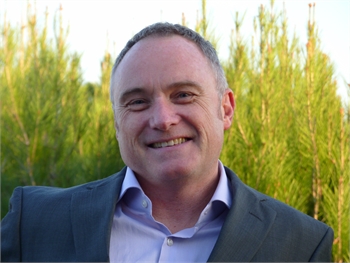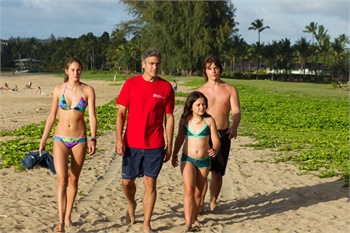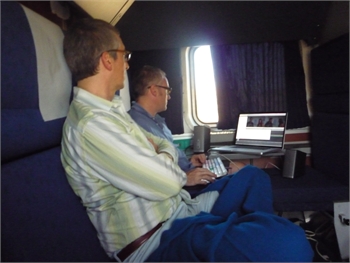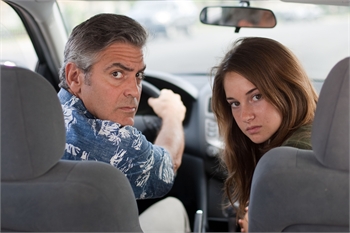| |
| Post Contender: Kevin Tent on Cutting "The Descendants" |
|
 Alexander Payne's critically acclaimed "The Descendants" marks the fifth time Payne has collaborated with editor Kevin Tent, ACE, so by now, Tent declares that the two of them have their shorthand down and their egos pretty much checked at the door during their lengthy and intense sessions in the editing suite. The result in this case was a film that has garnered quite a bit of awards' attention this season, including in the editing realm. The American Cinema Editors (ACE) not only nominated Tent this year in the Feature Film category for cutting "The Descendants," they were also slated at press-time to bestow their Golden Eddie Filmmaker of the Year honor on Payne. And, both men and the movie itself were also nominated for Oscars. Alexander Payne's critically acclaimed "The Descendants" marks the fifth time Payne has collaborated with editor Kevin Tent, ACE, so by now, Tent declares that the two of them have their shorthand down and their egos pretty much checked at the door during their lengthy and intense sessions in the editing suite. The result in this case was a film that has garnered quite a bit of awards' attention this season, including in the editing realm. The American Cinema Editors (ACE) not only nominated Tent this year in the Feature Film category for cutting "The Descendants," they were also slated at press-time to bestow their Golden Eddie Filmmaker of the Year honor on Payne. And, both men and the movie itself were also nominated for Oscars.
It's a rewarding time for Tent, who goes to great lengths to credit his intimate working relationship with Payne for such positive results. While the film was being shot in Hawaii, Tent and the rest of the editorial team worked on the assembly in Hollywood, and then moved to a Santa Monica cutting room for about seven months so that Payne and Tent could work closely together. They even had a few adventures cutting some of the movie at lead actor George Clooney's villa in Italy, and then, cutting remotely on board an Amtrak train on a cross-country trip following their Italy trip—"a fun time," according to Tent.
"Alexander and I get along—we have similar temperaments," Tent says. "We have different tastes in many ways, but they meet at a certain level. We are both hard on the material and if anything doesn't smell right or doesn't seem believable, we will do whatever we have to do to address it or figure out a solution. He is in the editing room with me all the time, which not all directors like to do. I actually do an early assembly while they are shooting, but Alexander and I don't really sit down and screen it together. I don't think we have screened an assembly together since 'About Schmidt' (2002). During production, I cut the scenes he's shot during the week, and send them to him on a DVD, usually every Friday. Some of them are tied together in big 10, 15, and 20 minute chunks. Sometimes, Alexander watches them over the weekend, and sometimes he doesn't, but usually by the time he shows up in the cutting room, he's caught up and watched all the scenes. However, our process lately has been to start from scratch once he's in the cutting room—he really doesn't watch dailies religiously during production anymore. If he suspects a problem, he will for sure, but he generally knows what he's shot and likes to rediscover it when he comes into the cutting room, starting with a fresh slate. So the first thing we do is start watching dailies. We'll select our favorite performances and start to rough in new versions of scenes. We'll go back now and then to see how I cut the scene originally, but for the most part, we start from scratch. It takes longer, and that can bug the studio, but I think they understand that's his process, and that the movies benefit from how he works."
 "Descendants," he adds, "did not have your standard structure" in the sense that the culminating scene in which Clooney's character confronts his wife's lover happens long before the film is over and might feel to an audience in some ways like the climax of the film. "So that made pace a challenge in the last third of the movie," Tent adds. He also says that other subtle creative questions, like whether the film should have flashed back to the character's marriage before his wife's tragic accident or explained in clearer detail what went wrong in their marriage, or whether there should have been more humor, and so on, were debated and discussed before and after a series of test screenings, but not always addressed in the way one might expect. To hear Tent explain the process of making these decisions in partnership with Payne during his conversation with Michael Goldman, CLICK HERE. "Descendants," he adds, "did not have your standard structure" in the sense that the culminating scene in which Clooney's character confronts his wife's lover happens long before the film is over and might feel to an audience in some ways like the climax of the film. "So that made pace a challenge in the last third of the movie," Tent adds. He also says that other subtle creative questions, like whether the film should have flashed back to the character's marriage before his wife's tragic accident or explained in clearer detail what went wrong in their marriage, or whether there should have been more humor, and so on, were debated and discussed before and after a series of test screenings, but not always addressed in the way one might expect. To hear Tent explain the process of making these decisions in partnership with Payne during his conversation with Michael Goldman, CLICK HERE.
Another creative issue that Tent grappled with was how best to use the beautiful cinematography captured by director of photography Phedon Papamichael, ASC, during production in Hawaii. Besides lending beauty to parts of the film, that material also helped Tent make transitions throughout the cutting process.
"The Hawaii shots had multiple purposes but were mainly used as transitions," he says. "They also worked as emotional beats and allowed time for the audience to feel what was happening in the story. It made my life easier, because when we needed an emotional beat, we had all these spectacular shots to pull from. There were definitely some shots that were so beautiful, we just had to figure out ways to work them into the movie. Like the montage (much of which was shot by second unit director Tracy Boyd and second unit DP Radan Popovic) near the end, the sort of transition part after the mother character dies and they are spreading her ashes in the water. Those shots were just spectacular, so we built up that sequence a bit."
Tent cut the film on the Avid Media Composer platform (v. 4.0.5) linked to about 2TB of Unity shared storage, working off HD dailies processed at Fotokem Burbank and delivered to editorial as Avid DNxHD36 media on FireWire drives. Tent credits his assistants for organizing the material and also for working closely with Modern VideoFilm, Burbank, where the digital intermediate process took place, and Custom Film Effects, Burbank, which handled the visual effects' work. First assistant Mindy Elliott, apprentice editor Mikki Levi, and post-production assistant Brian Bautista were able to do time warp and split screen comps on Media Composer to aid the visual effects' process, as well as creating temp effects for the traveling maps of Hawaii seen in the film using Adobe After Effects and Photoshop.
Additionally, the editorial team made extensive use of Avid's ScriptSync software to link audible dialogue with script text to make the editing process more seamless.
 "(The ScriptSync approach) perfectly fits Kevin's and Alexander's workflow," explains assistant editor Mindy Elliott. "Each scene had a folder, and within that folder, were the dailies' bin and a script for just that scene. (Levi) could do preliminary scripting of the dailies with ScriptSync, usually manually because that works better with Alexander's directing style. We also manually entered and scripted the voice-over, live musical performances, and a lot of non-verbal action. And ScriptSync was handy for Alexander and Kevin as they reviewed performances, since I could quickly reference back-up versions of scenes, and easily access corresponding scenes and takes." "(The ScriptSync approach) perfectly fits Kevin's and Alexander's workflow," explains assistant editor Mindy Elliott. "Each scene had a folder, and within that folder, were the dailies' bin and a script for just that scene. (Levi) could do preliminary scripting of the dailies with ScriptSync, usually manually because that works better with Alexander's directing style. We also manually entered and scripted the voice-over, live musical performances, and a lot of non-verbal action. And ScriptSync was handy for Alexander and Kevin as they reviewed performances, since I could quickly reference back-up versions of scenes, and easily access corresponding scenes and takes."
Indeed, Tent marvels at the advances of Media Composer, and editing technology in general even since the time he cut "Sideways" with Payne in 2004, calling the Avid "the most genius thing ever."
"We even cut on a train," he declares enthusiastically. "We flew back from Clooney's place in Italy, landed in New York, and took the (Amtrak) train to LA (Pictured Above). We cut for two days traveling cross-country. We could have never done that even a few years ago. Also, cutting in HD is great, and generally (since 'Sideways'), the workflow has gotten much better. We could give our music editor (Richard Ford) cut scenes at lunchtime. (Mindy Elliott) would upload them to a server, and within a couple of hours, Richard would re-cut the music and send it back. Mindy would quickly drop the music into our reels, and Alexander and I could evaluate. We did this back and forth process constantly. So for editors like me, who remember what it was like to cut on film going way back, this is fantastic."
—By Michael Goldman |
| |
 |
| |
| Post Contenders: Alexander Payne |
| |
|  On the other side of the collaboration between Kevin Tent and Alexander Payne is Payne's perspective from a Director's Chair interview with Iain Blair from the November 2011 issue of Post, which you can find by clicking HERE. In their conversation, Payne talked to Blair about the level of trust he has developed with Tent over the years, about the hard-to-spot visual effects in "The Descendants," the film's audio and DI processes, and about the joys of having final cut on his movies. As a side note, Payne added that his next film, "Nebraska," is being shot with the Arri Alexa digital camera—his first foray into digital acquisition. Check out the interview, and find ongoing coverage of this year's award contenders and winners, and conversations with the coming year's group of leading contenders, in upcoming issues of the Post Contenders newsletter. On the other side of the collaboration between Kevin Tent and Alexander Payne is Payne's perspective from a Director's Chair interview with Iain Blair from the November 2011 issue of Post, which you can find by clicking HERE. In their conversation, Payne talked to Blair about the level of trust he has developed with Tent over the years, about the hard-to-spot visual effects in "The Descendants," the film's audio and DI processes, and about the joys of having final cut on his movies. As a side note, Payne added that his next film, "Nebraska," is being shot with the Arri Alexa digital camera—his first foray into digital acquisition. Check out the interview, and find ongoing coverage of this year's award contenders and winners, and conversations with the coming year's group of leading contenders, in upcoming issues of the Post Contenders newsletter.
|
| |
|
|
|
|